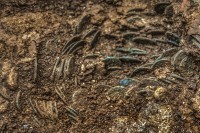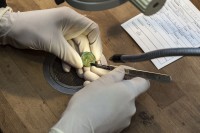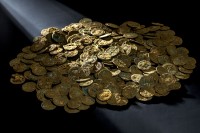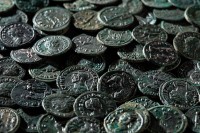 Farmer Alfred Loosli was walking through in his cherry orchard in Ueken in the northern Swiss canton of Aargau last year when he saw a green coin contrasted against the rich brown of the soil. At first the he assumed someone had lost it, but then he found another five. This July, Loosli poked a molehill under one of his cherry trees and found another 19 bronze coins. He asked his son to research the coins to see if they might be ancient, remembering that in 2013 a Roman settlement was discovered in the nearby city of Frick.
Farmer Alfred Loosli was walking through in his cherry orchard in Ueken in the northern Swiss canton of Aargau last year when he saw a green coin contrasted against the rich brown of the soil. At first the he assumed someone had lost it, but then he found another five. This July, Loosli poked a molehill under one of his cherry trees and found another 19 bronze coins. He asked his son to research the coins to see if they might be ancient, remembering that in 2013 a Roman settlement was discovered in the nearby city of Frick.
They called the authorities and in September canton archaeologists began to excavate the site. The excavation was kept secret to keep looters from interfering with the site when the archaeologists weren’t around, and it was productive beyond all expectations. By the end of the dig earlier this month, archaeologists had recovered 4155 Roman coins for a total weight of 33 pounds in just a few square meters. At least some of the coins were buried in cloth and leather bags and probably they all were only the bags have disintegrated.
 The hoard in now at the Vindonissa Museum in Brugg where conservators are painstakingly cleaning the coins. Swiss numismatist Hugo Doppler has examined the 200 coins cleaned thus far and has identified them as Antoniniani minted by emperors Aurelian (270-275), Tacitus (275-276), Probus (276-282), Carinus (283-285) Diocletian (284-305) Maximianus (286-305). The most recent were minted in 294 A.D. They are in exceptional condition. Hopper believes they were taken out of circulation almost immediately after minting.
The hoard in now at the Vindonissa Museum in Brugg where conservators are painstakingly cleaning the coins. Swiss numismatist Hugo Doppler has examined the 200 coins cleaned thus far and has identified them as Antoniniani minted by emperors Aurelian (270-275), Tacitus (275-276), Probus (276-282), Carinus (283-285) Diocletian (284-305) Maximianus (286-305). The most recent were minted in 294 A.D. They are in exceptional condition. Hopper believes they were taken out of circulation almost immediately after minting.
The Antoninianius coin is named after the emperor Caracalla (Marcus Aurelius Severus Antoninus Augustus) who first introduced the denomination in 215 A.D. as a silver piece worth two denarii, but because it only contained 1.5 denarii worth of silver, people raised prices and hoarded the coins causing rampant inflation. The Antoninianius became increasingly debased until by the reign of Emperor Gallienus in 268, the silver content was a meager 4%. Aurelian bumped it back up to 5%, but even that small boost was short-lived. At the end of the 3rd century, the Antoninianius was almost entirely bronze and considered worthless. People just threw them away.
 The 200 coins from the cherry orchard hoard, however, are all of particularly high silver content, about 5% silver. Hugo Doppler believes the owner of the hoard deliberately chose the coins with the highest silver content because they “would have guaranteed a certain value conservation in a time of economic uncertainty.” In a rural area like Ueken, there would have been no banks to put valuables in, and the area was subject to several Germanic incursions. Burying bags of relatively high silver content coins underground was a reliable method of keeping the treasure safe.
The 200 coins from the cherry orchard hoard, however, are all of particularly high silver content, about 5% silver. Hugo Doppler believes the owner of the hoard deliberately chose the coins with the highest silver content because they “would have guaranteed a certain value conservation in a time of economic uncertainty.” In a rural area like Ueken, there would have been no banks to put valuables in, and the area was subject to several Germanic incursions. Burying bags of relatively high silver content coins underground was a reliable method of keeping the treasure safe.
Significant hoards like these have been unearthed many times in Britain, but are much rarer in Switzerland. Only four Roman coin hoards of more than 4,000 pieces have been found in Switzerland. Two were discovered a century ago; the third was found last year in Orselina, 150 miles south of Ueken near the Italian border.
 The hoard will continue to be cleaned and examined. Doppler suspects there may be more exciting discoveries among the coins, like previously unknown mints and denominations. The hoard will eventually be put on public display at the Vindonissa Museum alongside other Roman artifacts discovered at the Frick excavation and elsewhere in the area.
The hoard will continue to be cleaned and examined. Doppler suspects there may be more exciting discoveries among the coins, like previously unknown mints and denominations. The hoard will eventually be put on public display at the Vindonissa Museum alongside other Roman artifacts discovered at the Frick excavation and elsewhere in the area.